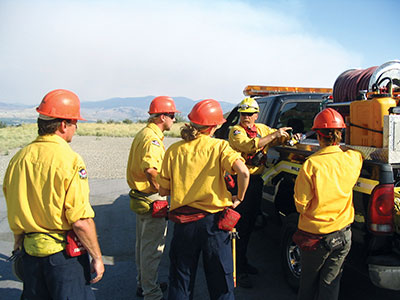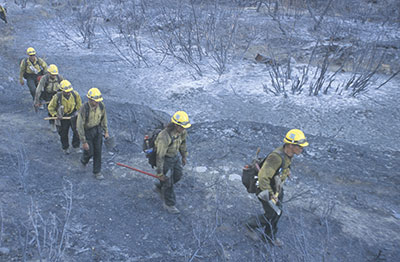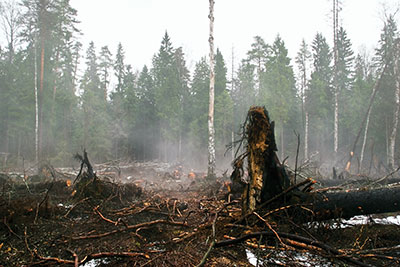
Features
Training
Trainer’s Corner: November 2013
During our fight with the fire dragon this past summer, our Hot Shot crew frequently took a few moments to reflect on the 19 LODDs in Prescott, Ariz.
November 12, 2013
By Ed Brouwer
During our fight with the fire dragon this past summer, our Hot Shot crew frequently took a few moments to reflect on the 19 LODDs in Prescott, Ariz. The speed at which things can go wrong on the fire line had a sobering effect on all of us. July 16 marked the 10-year anniversary of British Columbia’s worst wildland urban interface fires. It also marked the 10th anniversary of the line-of-duty deaths of Capt. Ian MacKay, 41, of Rossland, B.C., and Eric Ebert, his 36-year-old co-pilot. MacKay and Ebert were killed fighting a forest fire in eastern British Columbia when their plane struck high ground near Cranbrook. One month later, Ben von Hardenberg died fighting a forest fire in central British Columbia. He was killed when his helicopter crashed during a routine suppression operation. Ben was 33 years old and engaged to be married just days later.
 |
|
| Crew briefings are crucial; each firefighter should be informed of the LCES (Lookout, Communications, Escape routes, Safety zones) system during this briefing. Photo courtesy Ed Brouwer |
The very nature of wildland fire suppression demands continuous size-up and hazard evaluation. Wildland firefighter and academic Paul Gleason developed a system known as LCES in 1991 as a direct response to firefighter fatalities during the Dude fire in Arizona in 1990. There is a good training clip online (Search YouTube for Dude Fire Fatality Case Study).
LCES stands for lookout(s), communication(s), escape routes and safety zone(s). Gleason determined that firefighters were overloaded with all they had to remember about personal safety. His solution was LCES, which is used by many firefighters worldwide. Some firefighters add the letter A to the acronym but there is confusion about whether the A stands for attitude, anchor points or accountability – which are all good safety points. For the sake of clarity we will stick to the original LCES. These original points encompass the 18 watchout situations and the 10 fire orders, of which most wildland firefighters are aware. In light of recent events, I encourage every fire department to review the LCES system.
Lookout(s): This individual must be trained to observe the wildland fire environment and to recognize and anticipate wildland fire behaviour changes. The lookout(s) must:
- Be experienced, competent and trusted;
- Be at a good vantage point(s);
- Have knowledge of crew locations;
- Have knowledge of escape and safety locations;
- Have knowledge of trigger and/or decision points.
Communication(s): Whether by radio, voice, air horn or even hand signals, communication must be prompt and clear. The following four points are key:
- Confirm radio frequencies;
- Establish check-in times;
- Provide updates on any situation change;
- Sound alarms early, not late.
Escape routes: There must be more than one escape route. An escape route is the path firefighters take to go from a dangerous situation to a danger-free area. Each escape route must lead to a safety zone. These routes must be tested before they are flagged as escape routes. Remember the following:
- Have more than one escape route;
- Avoid steep uphill routes;
- Scout the route for loose soil, rocks and vegetation;
- Time the route to consider fatigue and heat factors;
- Flag the route for day or night;
- Evaluate escape time versus the rate of fire spread;
- Park vehicles nearby for quick escape.
Attempting to outrun an advancing flame front has too often ended in tragedy. As examples, research the Pepper Hill fire in Pennsylvania, the 1949 Mann Gulch fire in Montana, and the South Canyon fire in Colorado. Unfortunately, there is no shortage of examples. In the Dude fire video clip, you hear how crew members who were trying to outrun the fire front still carried their packs, hand tools and chainsaws. When it comes to fire entrapment, we emphasize avoidance, but perhaps it would be prudent for us to include survival skills.
Safety zone(s): These are locations where firefighters may take refuge from the wildfire danger. The best safety zone is of no value if your escape route does not offer you timely access when needed. Remember:
- Scout a safety zone for size and hazards.
- Do not avoid the most obvious place; just taking a few steps into the recently burned-over ground may be all that is required, though you may have to burn out an area first.
- Look for rocky areas, water and meadows, but remember, rocks will hold the heat long after the fire has passed.
- Also look for man-made areas, such as clear cuts, roads and helicopter landing pads.
- Avoid upslope areas. Fire behaviour shows us that the rate of spread triples when it reaches a 25 per cent increase in slope. Trying to outpace a fire for any significant distance, especially uphill, is a losing battle. Study the 1949 Mann Gulch and the 1994 South Canyon fires, and you will soon discover that firefighters are not able to outrun a rapidly advancing flame front, even on a moderately steep slope.
- Avoid smoky areas – protect your airway at all costs.
- Avoid regions with heavy fuel loads. Be sure to select an area that won’t burn, or that has the least amount of combustible material.
For historical reference, consider the Great Porcupine Fire of 1911. It was one of the most devastating forest fires ever to strike northern Ontario. Porcupine, a community on the north side of Porcupine Lake, in Timmins, was the site of a huge gold discovery in 1907. On July 11, 1911, when the Porcupine Gold Rush was at its height, a gale from the southwest whipped some small bush fires into flames. The front of the fire was more than 36 kilometres wide with flames shooting 30 metres into the air. The fire laid waste to about 200,000 hectares of forest and killed at least 70 people. Many people drowned as they fled into Porcupine Lake to escape the flames, while others suffocated as they sought refuge in the mines.
 |
|
| Wildland crews must have more than one escape route. Each route should lead to a safety zone and should be flagged in advance for day or night.
|
Before we do anything at a fire, no matter the size of the fire or the rank of the firefighter, we have a crew briefing. Each firefighter should be informed of the LCES system during this briefing. We identify escape routes and safety zones. We discuss strategy, weather and dangers. We give clear fire suppression directions, addressing crew members specifically by name. We do a radio check and then ask for comments or questions from the crew.
Along with LCES, we continually teach survival skills to our firefighters. The danger of being trapped or burned over and possibly
killed or seriously injured by a wildfire is a very real threat. Remember: victory loves preparation. Teach your firefighters survival skills and pray they never have to use them.
Teach them how to burn out fuels to create an area of safety or to enlarge an existing burned area. As Australian bushfire research pioneers Harry Luke and Alan McArthur noted in 1978, “Carrying a box of matches is part of survival planning.” We used to carry fusees (or flares), which are much more reliable and effective than matches, but they are hard to find now.
When caught in the open, survival may depend on taking advantage of every possible source of cover or protection from radiant and convective heat, for example, depressions in the ground, large rocks or logs. However, four firefighters died on a rockslide during the 2001 Thirty Mile fire in north-central Washington due in part to the accumulation of duff and rotting wood lodged in the rock crevices that ignited from airborne firebrands.
 |
|
| Firefighters can take refuge in designated safety zones. These regions should be scouted in advance, and can include roads, meadows, and even ground that has recently been burned-over.
|
Taking refuge in a natural body of water, such as a pond, lake or river, must be done with caution. In 1986, three firefighters in Quebec drowned as a result of being forced to enter a lake with a steep drop-off when their camp location was overrun by fire.
Last, but certainly not least, once you are in a safe zone, stay there until the threat that forced you into the safety zone is over. Firefighters die when they feel they have to do something. In the Thirty Mile fire, firefighters left the safe zone because they felt they should be doing something – and were forced back to its safety within 15 minutes. Unfortunately not everyone made it back safely. Those caught by the sudden fire behaviour change were forced to deploy their fire shelters. Tragically, four firefighters were killed.
The report looking into the 19 LODDs at the Yarnell Hill fire (available at www.azcentral.com/ic/pdf/yarnell-hill-fire-report.pdf) suggests quite a few similarities to the Thirty Mile fire.
The big question is why did the Granite Mountain Hot Shots leave the safe area in the already burned out region and hike through the thick, unburned fuels – some three metres high – down into the steep canyon as a powerful thunderstorm pushed flames directly at them.
I am baffled by that senseless decision, which in the end forced the Granite Mountain Hot Shots to deploy their fire shelters. Every crew leader knows that deployment of a fire shelter is a last-ditch effort in a life-and-death situation. It speaks to the fact that they should never have been in that area to begin with.
There are times when the phrase, “Don’t just stand there, do something,” should be “Don’t just do something, stand there.” When fighting a particularly risky fire, we have to trust that sometimes the best thing to do is nothing.
Until next time, train like lives depend on it, because they do. Let no firefighter’s ghost say that his training let him down!
Ed Brouwer is the chief instructor for Canwest Fire in Osoyoos, B.C., and Greenwood Fire Rescue. The 24-year veteran of the fire service is also a fire warden with the B.C. Ministry of Forests, a Wildland Urban Interface fire suppression instructor/evaluator and an ordained disaster-response chaplain. Contact Ed at ebrouwer@canwestfire.org
Print this page